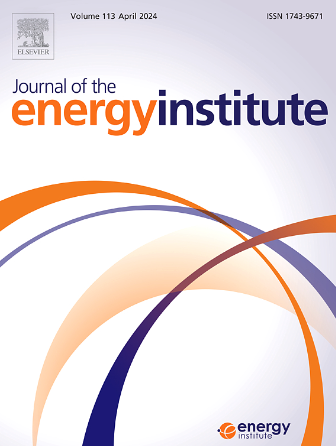Investigation of the formation mechanisms of nitrogen-based pollutants in ammonia-diesel dual-fuel engines by decoupling dilution, thermal, and kinetic effects
IF 5.6
2区 工程技术
Q2 ENERGY & FUELS
引用次数: 0
Abstract
This paper investigates the dynamic formation and conversion mechanisms of nitrogen-based pollutants in ammonia-diesel dual-fuel engines, where ammonia (NH3) is introduced via port fuel injection. The dynamic mechanisms behind pollutant formation in this context are not well understood, primarily due to the focus in existing literature on decoupling thermal-type and fuel-type nitrogen-based pollutants in three-dimensional (3D) computational fluid dynamics (CFD) simulations of ammonia-diesel operation, which distorts the natural spatiotemporal distribution and kinetic interactions of nitrogen-based pollutants, thus falling short of fully revealing the real dynamic mechanisms. Rather than distinguishing the nitrogen sources from ammonia or atmospheric nitrogen, this study proposes an innovative approach by decoupling the dilution, thermal, and kinetic effects of ammonia in the 3D CFD model, enabling a detailed analysis of the dynamic formation and conversion mechanisms of nitrogen-based pollutants. Given the significant impact of ammonia kinetic effects, the study also introduces a novel method of partial closure of ammonia kinetics to examine the influence of gas movement. The results indicate that ammonia kinetics do not significantly alter the regions where nitrogen-based pollutants form (i.e., nitrogen oxides (NOx) in pure diesel engines), as ammonia oxidation occurs co-combustively with diesel in regions reached by the diesel plume in ammonia-diesel dual-fuel operation. However, ammonia kinetics affect the types and concentrations of nitrogen-based pollutants in these regions, such as increasing the concentration of nitrogen monoxide (NO) in high-temperature zones. The momentum of the bulk gas generated by the spray jet, piston downward movement, and combustion pushes the hot combustion products toward the unburned ammonia-air mixture, allowing NO formed during the main combustion stage and NH3 remaining from the main combustion stage to meet, facilitating the de-NOx effect of ammonia, which results in nitrogen (N2) formation when the process is locally efficient and nitrous oxide (N2O) formation when it is not. Within the combustion chamber, N2O is found in cooler regions with limited NO concentration. Some of the N2O comes from the flow of N2O surviving from the main combustion stage, while the remainder is generated by the inefficiency of the ammonia de-NOx effect during the late combustion stage. In the exhaust gases, the concentration of N2O is comparable to NO, making it a major nitrogen-based pollutant. Although nitrogen dioxide (NO2) is not a major component in the exhaust, it plays a crucial role in N2O formation, as evidenced by its spatiotemporal distribution, which mirrors that of N2O. Overall, the turbulent gas flow and ammonia de-NOx kinetics together influence the spatiotemporal distribution of nitrogen-based pollutants after the main heat release stage inside the combustion chamber, resulting in a complex composition and concentration of nitrogen-based pollutants that need to be considered for aftertreatment control.
氨柴油双燃料发动机中氮基污染物形成机制的解耦稀释、热和动力学效应研究
本文研究了氨柴油双燃料发动机中氨(NH3)的动态形成和转化机理。在这种情况下,污染物形成的动力机制尚不清楚,主要原因是现有文献在氨柴油操作的三维(3D)计算流体动力学(CFD)模拟中关注热型和燃料型氮基污染物的解耦,这扭曲了氮基污染物的自然时空分布和动力学相互作用,从而未能充分揭示真实的动力机制。本研究提出了一种创新的方法,即在三维CFD模型中解耦氨的稀释效应、热效应和动力学效应,而不是将氮源与氨或大气氮区分开来,从而可以详细分析氮基污染物的动态形成和转化机制。鉴于氨动力学效应的显著影响,本研究还引入了氨动力学部分封闭的新方法来检验气体运动的影响。结果表明,氨动力学并没有显著改变氮基污染物形成的区域(即纯柴油发动机中的氮氧化物(NOx)),因为氨氧化在氨-柴油双燃料运行中柴油羽流到达的区域与柴油共燃。然而,氨动力学影响了这些地区氮基污染物的类型和浓度,例如增加高温地区的一氧化氮(NO)浓度。喷射、活塞向下运动和燃烧产生的大块气体的动量将热燃烧产物推向未燃烧的氨-空气混合物,使主燃烧阶段形成的NO与主燃烧阶段剩余的NH3相遇,有利于氨的脱硝作用,当该过程局部有效时形成氮气(N2),当该过程局部无效时形成氧化亚氮(N2O)。在燃烧室内,N2O存在于NO浓度有限的较冷区域。部分N2O来自主燃烧阶段残存的N2O流动,其余则是燃烧后期氨氮脱硝效果的无效产生的。在废气中,N2O的浓度与NO相当,是主要的氮基污染物。二氧化氮(NO2)虽然不是废气的主要成分,但它在N2O的形成中起着至关重要的作用,其时空分布反映了N2O的时空分布。总的来说,湍流气流和氨氮脱硝动力学共同影响了燃烧室内主放热阶段后氮基污染物的时空分布,导致氮基污染物的组成和浓度复杂,需要考虑后处理控制。
本文章由计算机程序翻译,如有差异,请以英文原文为准。
求助全文
约1分钟内获得全文
求助全文
来源期刊

Journal of The Energy Institute
工程技术-能源与燃料
CiteScore
10.60
自引率
5.30%
发文量
166
审稿时长
16 days
期刊介绍:
The Journal of the Energy Institute provides peer reviewed coverage of original high quality research on energy, engineering and technology.The coverage is broad and the main areas of interest include:
Combustion engineering and associated technologies; process heating; power generation; engines and propulsion; emissions and environmental pollution control; clean coal technologies; carbon abatement technologies
Emissions and environmental pollution control; safety and hazards;
Clean coal technologies; carbon abatement technologies, including carbon capture and storage, CCS;
Petroleum engineering and fuel quality, including storage and transport
Alternative energy sources; biomass utilisation and biomass conversion technologies; energy from waste, incineration and recycling
Energy conversion, energy recovery and energy efficiency; space heating, fuel cells, heat pumps and cooling systems
Energy storage
The journal''s coverage reflects changes in energy technology that result from the transition to more efficient energy production and end use together with reduced carbon emission.
 求助内容:
求助内容: 应助结果提醒方式:
应助结果提醒方式:


